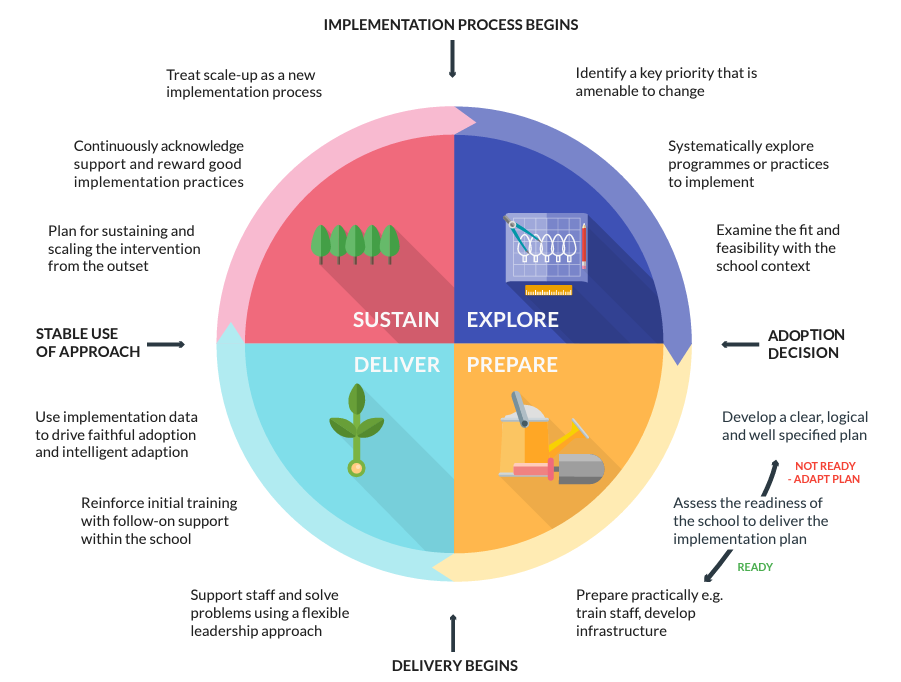Middle Leadership Blog Series Theory Post 2
Frameworks for successful implementation

Who is this blog post for: Current or emerging middle leaders and for senior leaders or Headteachers who are developing middle leaders.
Author: Stephanie Bingham
Posted on: 18th July 2023
Keywords: Implementation; coalition; evidence; team; communication
Introduction
In our last reflection post we outlined some of the pitfalls and complexities associated with implementation and invited you to reflect upon the experiences you have had of successful and less successful implementation. We also outlined the skills which effective teachers can transfer from their teaching to their leadership, and to implementation in particular.
In this theory post, we will outline some of the evidence on successful implementation and share some models which should help you as you consider your leadership of change.
Key aspects of successful implementation
There are hundreds of articles and research papers exploring the different aspects of implementation relating to contexts ranging from behavioural science to business management. This reflects, as we have stated above, how complex implementation is and should reassure you that if you have struggled with making change happen, you are not alone and the reasons will also be complex.
The EEF Guidance on Implementation recommends a four-stage approach to implementing change in a school: Explore, Prepare, Deliver, Sustain. This model was devised following an extensive review of the academic literature on implementation generally and in schools specifically. It provides a useful method for avoiding the pitfalls we have identified, and is a good demonstration of transferring the skills used in curriculum planning and delivery to the implementation of change within or across a school.

The premise of the EEF report is that schools often rush at introducing new practice without carrying out adequate preparation. In it, the authors advise us to ‘treat implementation as a process, not an event; plan and execute it in stages’. Their four-stage approach, pictured above, provides a framework for planning for and embedding sustainable change which will have a lasting impact on teacher practice and student outcomes. They emphasise the importance of gathering evidence from within the setting as well as in relation to potential solutions, and of doing a significant level of preparation before starting on the change itself. This preparation is essential if the implementation is to succeed in the long term: far too many interventions in schools are short-lived due to a failure to plan beyond the initial stages. Monitoring and adjustment are key features of successful change, just as they are of effective classroom practice, and central to this is the regular gathering of data to inform decisions.
The EEF model reflects recommendations from other researchers such as John Kotter, whose 8 steps for change are pictured below:

One of the important aspects of Kotter’s (1995) model for middle leaders to absorb is the acknowledgement that people are often one of the main barriers to successful implementation, but they are also the key to making things happen. Therefore, in addition to the research you do into the evidence for the proposed change, as stated in our reflection post on implementation it is crucial to communicate clearly and involve your team in the decision making. This is particularly the case in schools, where the majority of the workforce is likely to be working at capacity and within well-established routines and agreed practice: you will need to invest time into ‘building your coalition’. To be successful you need a group of colleagues who will assist, encourage and support the implementation of the identified change (the ‘coalition’) from the beginning – successful leadership is not about working top down or in isolation. As the plan progresses, the coalition should build and there will eventually be a more widespread enthusiasm for the change. As the EEF report stresses, it is much easier to gain support for a vision or plan if it is rooted in sound evidence and meets a known need in your school. Proposing to address the known need through an evidence-led solution is how you create what Kotter (1995) calls a ‘Sense of Urgency’: people will come with you if they identify with the need, not just the action, and if the evidence resonates with what they already know and observe in their classrooms. Note that this use of ‘urgency’ relates to the importance of the proposed change: it is different from the type of urgency alluded to in the EEF guidance and cited in the reflection post on Implementation, which equates with haste and rushing at change.
When reflecting on how to approach your team to propose a change in practice or a new intervention, Roger’s ‘Diffusion of Innovation Theory’ (1995) is worth considering. It includes a useful depiction of how quickly people are likely to adopt new ideas or practice and embed them in their own practice:

Different people will adopt new practice or technology at different stages: knowing this in advance and factoring it into your planning will help you to succeed in embedding the change more effectively. Across our teaching and leadership journeys we have all expended so much energy trying to win over the group Roger (1995, 2003) calls the ‘laggards’, when the biggest impact is far more likely to come by working with the people on the early side of the median – your potential ‘coalition’. Both Kotter (1995) and Sharples et al. (2019) stress the need to support staff and remove barriers – sometimes this might include ignoring the few who actively or passively resist the change.
Coming soon!
Case study on implementation, demonstrating how these models play out in a real context.
References
- Kotter, J. P. (2012). Leading change. Boston, Mass: Harvard Business Review.
-
Rogers, E.M. (2003) Diffusion of Innovations. Free Press, New York.
-
Sharples, J., Albers, B., Fraser, S. and Kime, S. (2021) Putting Evidence to work: A school’s guide to implementation, Education Endowment Fund.
